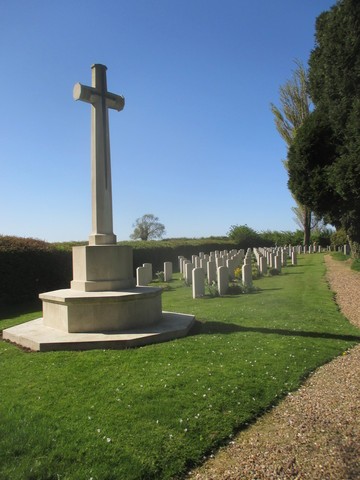Post by frankmcvey (Angel) on Apr 22, 2020 12:00:38 GMT
RAF Cottesmore - ANZAC War Graves.kmz (6.52 KB)
This is the little Commonwealth War Graves Commission graveyard at Cottesmore, a few hundred yards from my home and fairly close to the large former airbase of RAF Cottesmore, now an Army Barracks.

There are more than 90 WW2 war graves here; as you'd expect the majority of them are RAF graves, but there are a significant number of Commonwealth airmen buried here, with all of the larger countries represented; Australia, Canada, New Zealand, South Africa and Southern Rhodesia.
There were relatively few operational combat sorties flown from RAF Cottesmore in the early stages of the war; it was a flying training unit, No 14 OTU, designed to convert trainee aircrew from their ab initio training, flying small single-engined trainers, to flying multi-engined heavier aircraft in preparation for their eventual conversion to the mainstay heavy bombers, such as the Avro Lancaster, the Short Stirling and the Handley-Page Halifax.
Naturally, Bomber Command required new, state-of-the art machines for operations, so most of the flying training at Cottesmore was carried out on old, tired, obsolescent aircraft no longer fit for operational service; the backbone of the 14 OTU fleet was the Handley-Page Hampden medium bomber.

This is the little Commonwealth War Graves Commission graveyard at Cottesmore, a few hundred yards from my home and fairly close to the large former airbase of RAF Cottesmore, now an Army Barracks.

There are more than 90 WW2 war graves here; as you'd expect the majority of them are RAF graves, but there are a significant number of Commonwealth airmen buried here, with all of the larger countries represented; Australia, Canada, New Zealand, South Africa and Southern Rhodesia.
There were relatively few operational combat sorties flown from RAF Cottesmore in the early stages of the war; it was a flying training unit, No 14 OTU, designed to convert trainee aircrew from their ab initio training, flying small single-engined trainers, to flying multi-engined heavier aircraft in preparation for their eventual conversion to the mainstay heavy bombers, such as the Avro Lancaster, the Short Stirling and the Handley-Page Halifax.
Naturally, Bomber Command required new, state-of-the art machines for operations, so most of the flying training at Cottesmore was carried out on old, tired, obsolescent aircraft no longer fit for operational service; the backbone of the 14 OTU fleet was the Handley-Page Hampden medium bomber.

Royal Air Force official photographer; The original uploader was Bzuk at English Wikipedia., 28 May 2007 (original upload date)
This is photograph COL182 from the collections of the Imperial War Museums.
This is photograph COL182 from the collections of the Imperial War Museums.
This was a twin-engined aircraft with a 4-man crew; although it was equipped with several machine-guns, these were either fixed or swivel-mounted and gave a much inferior defensive capability when compared to aircraft with power-operated gun turrets. In the early stages of the war it suffered heavy losses in daylight and was quickly relegated to night operations. It had a deep but very narrow fuselage that could only accommodate a single-seat cockpit, a huge disadvantage in a training aircraft, since there was no experienced pilot to take over if the student pilot had problems.
The Hampden had a reputation for being a nice aircraft to fly within its limits, but it proved to be very unforgiving if mishandled; for example, if on take-off the pilot mistakenly raised the flaps before raising the undercarriage, the aircraft was liable to stall. Additionally, it swung badly on take-off and was prone to entering a deadly spin if it lost an engine in flight. Consequently, the flying accident rate was high, and, with a few exceptions, the graves at Cottesmore are those of young student pilots who had gotten in trouble, killing themselves and their fellow crew-members. Together with its satellite airfields of Woolfox Lodge and Saltby, Cottesmore lost 53 Hampdens and Herefords (a variant of the Hampden, but with different engines) between October 1939 and November 1942; almost all were training accidents. The placemarks in the .kmz tell their stories.
Cottesmore St Nicholas ANZAC Roll of Honour
Sgt J E Wall RNZAF (Obs) died on 12 September 1941 age 19. Son of William and Margaret Emily Wall, of Harihari, Westland, New Zealand.
Sgt Wilford John Collins (Pilot) RNZAF died on 6th December 1942 age 23. Husband of Mrs Z F Collins, of Auckland, and twin son of Mr and Mrs E S. Collins, of 70 Green Lane Remuera.
Sgt Brian Wentworth Bucknell RAAF died on 27th November 1941 age 21. Son of Keith Edman Bucknell, and Laurie Adela Bucknell, of Graman, New South Wales, Australia.
Sgt Kenneth Frederick Thornton RAAF died on 9th December 1941 age 25. Son of Arthur Charles and Edith Pearl Thornton, and husband of Norma Genevieve Thornton of Bathurst, NSW, Australia.
Sgt Edward O'Connell RAAF died on 26th January 1942 age 27. Son of Patrick Francis and Louisa Jeanette O'Connell, of Sydney, New South Wales, Australia.
Pilot Officer Osborne Kirkton Fisher RAAF died on 9th December 1941 age 28, from Leederville in Western Australia.
Sgt Francis James Hiesler RAAF died on 16 March 1942 age 24.
Pilot Officer Walter Hugh Lynch RAAF died on 26th January 1942 age 26. Son of John Patrick and Elizabeth Mary Lynch, of Lane Cove, New South Wales, Australia.
Sgt Allan Harold Hanson RAAF died on 88th March 1942 age 27. Son of Hans Victor Hanson and Annie Victoria Hanson nee Stager of Ayr, Queensland, Australia.
Sgt James Alexander Stevenson RAAF died on 16th March 1942 age 20. Son of James Alexander and Janet Whitelaw Stevenson of Toowoomba, Queensland, Australia.
Sgt Jack Lawton Walker RAAF died on 14 April 1942 age 23. Son of Robert Frank and Elizabeth Walker, of Geelong West, Victoria, Australia.
Sgt A A Weir RAAF died on 2nd June 1942 age 19. Son of Albert Allen & Ethel Maude Weir, Cloncurry, Queensland, Australia.
Pilot Officer Sydney Stanley White RAAF died on 26th January 1942 age 27. Son of George Thomas White and Harriott Ruby White, of Wooloowin, Queensland, Australia.
Sgt Alan Richard Frazer RAAF died on 27th March 1942 age 21.
Sgt William John Nicholls RAAF died on 29th April 1942 age 20. Son of John Leslie and Lena Harriet Nicholls of Lochiel, South Australia
Sgt James Darien Henning RAAF (Observer) died on 6th June 1942, age 27. Son of Henry Herbert and Amy Ethel Henning of Pymble, NSW, Australia.
Sgt Druce Hawthorne Barton RAAF, W Op/Air Gunner, died on 11th August 1942, age 21.
Sgt W T Cuthbertson RAAF died 31st March 1943 age 21.
Oh! I have slipped the surly bonds of Earth
And danced the skies on laughter-silvered wings;
Sunward I’ve climbed, and joined the tumbling mirth
Of sun-split clouds, – and done a hundred things
You have not dreamed of – wheeled and soared and swung
High in the sunlit silence. Hov’ring there,
I’ve chased the shouting wind along, and flung
My eager craft through footless halls of air…
Up, up the long, delirious burning blue
I’ve topped the wind-swept heights with easy grace
Where never lark, or ever eagle flew –
And, while with silent, lifting mind I’ve trod
The high untrespassed sanctity of space,
Put out my hand, and touched the face of God.
The Hampden had a reputation for being a nice aircraft to fly within its limits, but it proved to be very unforgiving if mishandled; for example, if on take-off the pilot mistakenly raised the flaps before raising the undercarriage, the aircraft was liable to stall. Additionally, it swung badly on take-off and was prone to entering a deadly spin if it lost an engine in flight. Consequently, the flying accident rate was high, and, with a few exceptions, the graves at Cottesmore are those of young student pilots who had gotten in trouble, killing themselves and their fellow crew-members. Together with its satellite airfields of Woolfox Lodge and Saltby, Cottesmore lost 53 Hampdens and Herefords (a variant of the Hampden, but with different engines) between October 1939 and November 1942; almost all were training accidents. The placemarks in the .kmz tell their stories.
Cottesmore St Nicholas ANZAC Roll of Honour
Sgt J E Wall RNZAF (Obs) died on 12 September 1941 age 19. Son of William and Margaret Emily Wall, of Harihari, Westland, New Zealand.
Sgt Wilford John Collins (Pilot) RNZAF died on 6th December 1942 age 23. Husband of Mrs Z F Collins, of Auckland, and twin son of Mr and Mrs E S. Collins, of 70 Green Lane Remuera.
Sgt Brian Wentworth Bucknell RAAF died on 27th November 1941 age 21. Son of Keith Edman Bucknell, and Laurie Adela Bucknell, of Graman, New South Wales, Australia.
Sgt Kenneth Frederick Thornton RAAF died on 9th December 1941 age 25. Son of Arthur Charles and Edith Pearl Thornton, and husband of Norma Genevieve Thornton of Bathurst, NSW, Australia.
Sgt Edward O'Connell RAAF died on 26th January 1942 age 27. Son of Patrick Francis and Louisa Jeanette O'Connell, of Sydney, New South Wales, Australia.
Pilot Officer Osborne Kirkton Fisher RAAF died on 9th December 1941 age 28, from Leederville in Western Australia.
Sgt Francis James Hiesler RAAF died on 16 March 1942 age 24.
Pilot Officer Walter Hugh Lynch RAAF died on 26th January 1942 age 26. Son of John Patrick and Elizabeth Mary Lynch, of Lane Cove, New South Wales, Australia.
Sgt Allan Harold Hanson RAAF died on 88th March 1942 age 27. Son of Hans Victor Hanson and Annie Victoria Hanson nee Stager of Ayr, Queensland, Australia.
Sgt James Alexander Stevenson RAAF died on 16th March 1942 age 20. Son of James Alexander and Janet Whitelaw Stevenson of Toowoomba, Queensland, Australia.
Sgt Jack Lawton Walker RAAF died on 14 April 1942 age 23. Son of Robert Frank and Elizabeth Walker, of Geelong West, Victoria, Australia.
Sgt A A Weir RAAF died on 2nd June 1942 age 19. Son of Albert Allen & Ethel Maude Weir, Cloncurry, Queensland, Australia.
Pilot Officer Sydney Stanley White RAAF died on 26th January 1942 age 27. Son of George Thomas White and Harriott Ruby White, of Wooloowin, Queensland, Australia.
Sgt Alan Richard Frazer RAAF died on 27th March 1942 age 21.
Sgt William John Nicholls RAAF died on 29th April 1942 age 20. Son of John Leslie and Lena Harriet Nicholls of Lochiel, South Australia
Sgt James Darien Henning RAAF (Observer) died on 6th June 1942, age 27. Son of Henry Herbert and Amy Ethel Henning of Pymble, NSW, Australia.
Sgt Druce Hawthorne Barton RAAF, W Op/Air Gunner, died on 11th August 1942, age 21.
Sgt W T Cuthbertson RAAF died 31st March 1943 age 21.
Oh! I have slipped the surly bonds of Earth
And danced the skies on laughter-silvered wings;
Sunward I’ve climbed, and joined the tumbling mirth
Of sun-split clouds, – and done a hundred things
You have not dreamed of – wheeled and soared and swung
High in the sunlit silence. Hov’ring there,
I’ve chased the shouting wind along, and flung
My eager craft through footless halls of air…
Up, up the long, delirious burning blue
I’ve topped the wind-swept heights with easy grace
Where never lark, or ever eagle flew –
And, while with silent, lifting mind I’ve trod
The high untrespassed sanctity of space,
Put out my hand, and touched the face of God.

